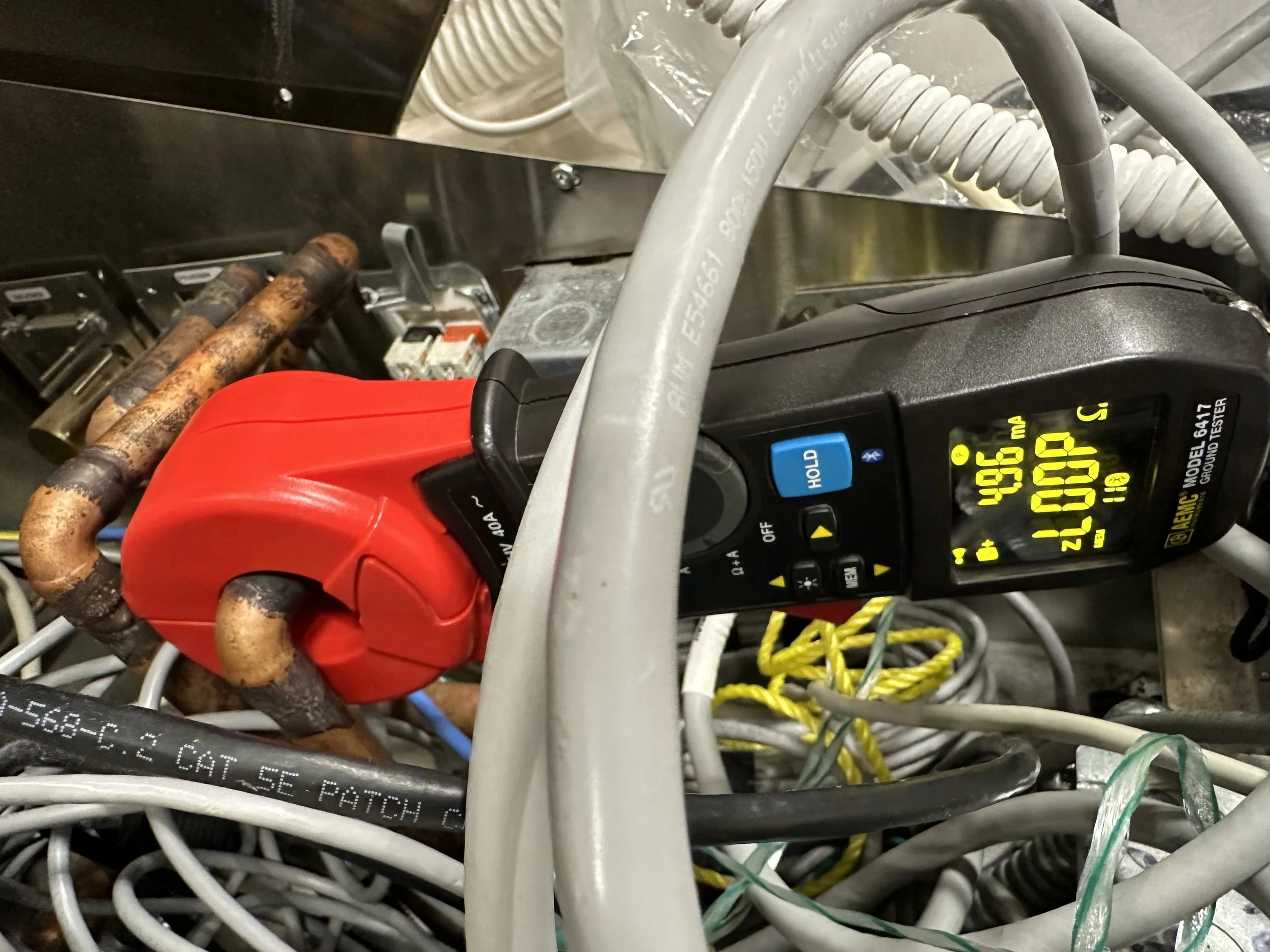Recently, I reviewed a report as a third-party consultant for a client who needed a second opinion. In the report, the engineer used a Fluke 323 Clamp Multimeter to measure the impedance on a building’s ground conductor. Because this meter can measure impedance, many get tricked into thinking it can measure a ground system's impedance. Although this tool is excellent and used by many electricians, it was incorrect for this job.
Here is an outline explaining why this is the wrong tool and some tool suggestions for the next time.
This is one of several correct tools, an AEMC 6417 Ground Tester, for measuring a system ground that Elexana utilizes.
Why a Multimeter Is Inadequate for Ground Impedance and Ground Loop Detection
1. Measurement Frequency Limitation
Multimeters measure impedance using DC or very low-frequency AC (in the case of True RMS meters).
Ground impedance relevant to safety and EMI performance must be evaluated at 50/60 Hz and higher frequencies (e.g., several kHz or even MHz for EMI).
Ground loops can involve complex impedance behavior due to parasitic inductance and capacitance, which a multimeter cannot resolve.
2. Insufficient Current Injection
Proper ground impedance testing requires injecting a high current (25 A or more) into the earth electrode and measuring voltage drop (per standards like IEEE 81 or NEC 250).
A multimeter provides microamp to milliamp current, which is insufficient to develop a measurable voltage drop across low-impedance ground systems (often < 1 ohm).
3. Cannot Isolate Parallel Paths
The grounding system in a facility has many parallel paths (building steel, water pipes, cable trays, etc.).
A multimeter cannot distinguish between these paths or model their inductive coupling, meaning it cannot identify unintended loop currents or impedance differentials.
4. No Differential or Noise Detection Capability
Ground loops often arise due to minute voltage differences (millivolt to volt scale) between ground reference points under load or EMI conditions.
Multimeters cannot effectively isolate AC noise, ripple, or transient voltages across these ground paths, especially in the presence of switching power supplies, VFDs, or large equipment.
Best Tools for Testing Ground Impedance and Ground Loops
A. Ground Electrode Impedance Testing (Low-Frequency, Safety-Oriented)
Clamp-On Ground Resistance Testers
Example: Fluke 1630-2 FC or AEMC 6416
Measure ground loop impedance without disconnecting the ground rod.
Use current injection and voltage sensing coils to compute ground impedance in situ.
Best for bonded systems and electrical safety evaluations.
3-Point or 4-Point Fall-of-Potential Test Kits
Example: Megger DET4TC2 or AEMC 4620
Used for soil electrode testing per IEEE 81 and IEC 60364, especially in unbonded grounding systems.
Injects known current into the earth and measures potential drop at various distances.
B. Ground Loop and Noise Identification (AC Noise, EMI, Safety)
Oscilloscope with Differential Probes
Use Case: Detect high-frequency or transient ground loop voltages, such as from VFDs or data systems.
Enables visualization of non-sinusoidal voltages and high-frequency disturbances.
Use a low-voltage differential probe (e.g., Tektronix TDP0500 or Pico TA043).
AC Leakage Current Clamp Meter (High Sensitivity)
Example: Fluke 369 FC (sensitivity down to 60 µA)
Measures unintended ground currents, leakage, or circulating currents.
Helps identify ground loops by comparing current paths across different grounding bonds.
Power Quality Analyzer or EMI Analyzer
Example: Fluke 435-II or Narda EHP-50C
Measures harmonics, transients, and noise currents on grounding conductors.
Useful in industrial or EMI-sensitive environments.
Signal Injectors and Ground Loop Testers
Inject a known AC signal on a ground conductor and detect unexpected paths or voltage differentials.
Some EMC consulting tools include signal tracing with phase tracking to map unintended loop routes.
Summary
A multimeter is a scalar, low-energy, low-frequency tool that cannot measure complex impedance, detect noise voltages, or model multi-path grounding systems.
Use clamp-on ground testers and 3/4-point test kits for impedance and differential probes, AC leakage clamps, and EMI analyzers for ground loops and interference.
©2025 All Rights are Reserved.

